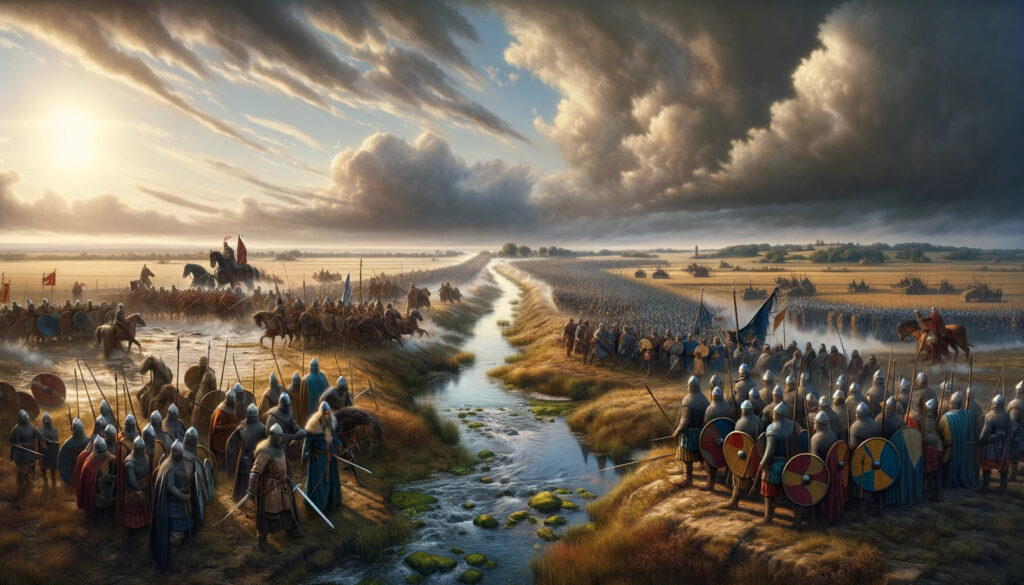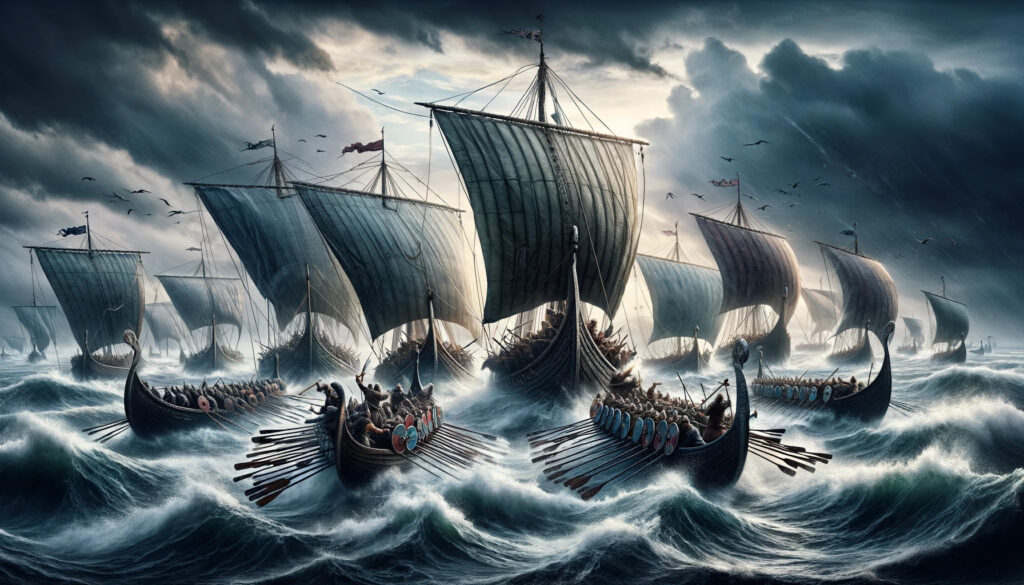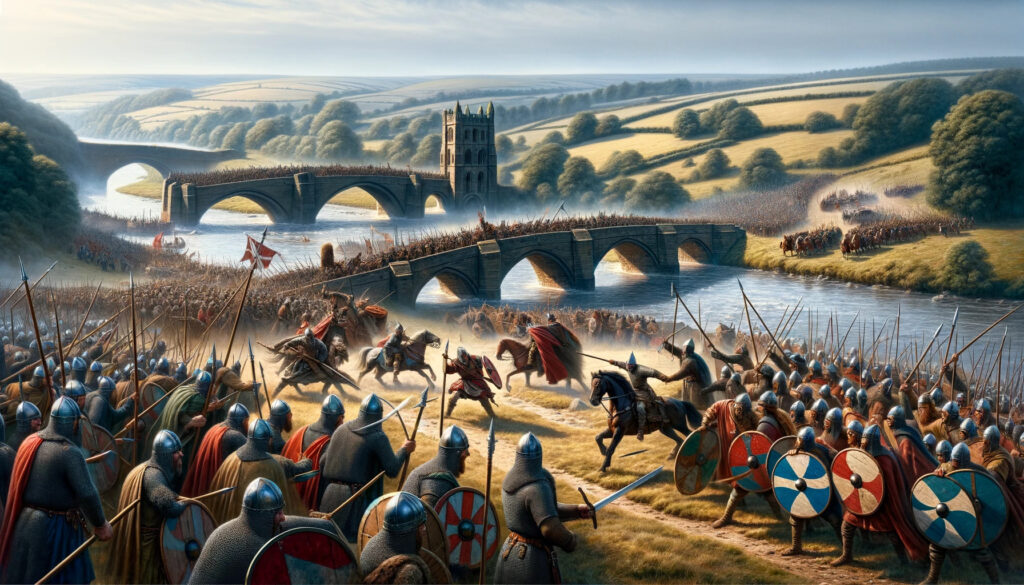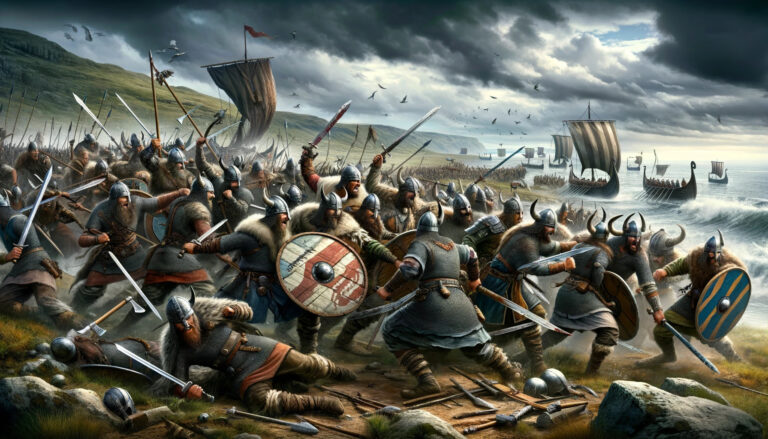The Vikings are known for their prowess and warriors, so, unsurprisingly, they have been involved in some of the bloodiest battles in history.
While the details of how many men were involved and died in battle are often fantastical and speculative, they clearly left behind bloody battlefields.
But what are some of the most legendary Viking battles?
Below are my top six picks. Some have been selected for their unimaginable death toll, while others were chosen because they were pivotal moments in history.
Siege of Paris – France, 845

The Siege of Paris by the infamous Ragnar Lothbrok was the culmination of the Viking invasion of West Francia with a fleet of 120 ships up the Seine River.
This was a surprise for the French since the different technology of Viking ships allowed them to sail in shallow waters.
The Vikings began raiding in France in 799, which led the French King Charlemagne to create a defensive system along the northern coast in 810, which had mixed success. In 845, Ragnar arrived with his large fleet and force of 5,000 men and sailed up the Seine, passing a weak point in the defenses.
King Charles the Bald, who had previously been in an alliance with Ragnar, fell back to Paris and divided his forces into two, placing one part on either side of the river.
The Vikings attacked one side first, winning a decisive victory and hanging 111 French soldiers on an island on the Seine to incite terror in the remaining soldiers.
Hanging was a way of dedicating them to the god Odin, who hung himself from the world tree Yggdrasil for nine days and nights to learn the secrets of the runes.
On Easter, the Vikings reached the city, which they plundered. They were only stopped when a plague broke out in their camp.
Nevertheless, the French were unable to pull together an effective force while the Vikings recovered, so the Vikings were able to demand a ransom of 7,000 livres of silver (5,670 pounds).
This became the first of thirteen payments of danegeld to stop the Vikings from raiding Paris and other important sites.
Battle of Edington – England, 878

While the Vikings raided England consistently throughout the 9th century, the dynamics changed around 865 when the Vikings gathered the Great Heathen Army, supposedly to avenge the execution of Ragnar Lothbrok. Rather than plundering, this army wanted to conquer.
There is much debate over the size of the army, but it is estimated that there were around 500,000 Vikings in England.
The main leaders were Ragnar’s sons Ivar the Boneless, Ubba, and Halfdan Ragnarsson. By 870, the Vikings had conquered Northumbria and East Anglia, took Wessex in 871, and Mercia in 874.
But some of the Vikings considered this a final success and left England.
By 878, the Vikings held the east and northeast of England and Alfred the Great commanded the remaining English forces.
Initially, Alfred ineffectually chased the Danes around Wessex and suffered several serious losses.
In May 878, Alfred recruited more men at a gathering at Egbert’s Stone, and the English king led a larger force against the Danes.
They met just outside the fortress of Chippenham, which was controlled by the Vikings. But the English effectively executed a shield wall tactic, turning a Viking tactic back upon them, resulting in a bloody battle that pushed the Vikings back to the fortress.
They were besieged there for 14 days before surrendering. The Vikings withdrew from Wessex to other Viking-controlled lands.
While the English realized they could not push the Vikings fully out of their territory, they strengthened the kingdom with a series of border fortresses and also forced the Vikings who surrendered to convert to Christianity.
The Viking leader Guthrum was one of the first to be baptized and took the name Athelstan. He was also the first Viking leader to start minting coins in the Wessex style to facilitate trade.
Battle of Maldon – England, 991

By the 10th century, Viking raids in England had calmed down and most of the English were paying them to maintain the peace.
But an Earl of Essex called Byrhtnoth decided that the Vikings should be dealt with using force. He gathered forces to face the threat.
Viking forces of between 2,000-4,000 men faced off with the smaller English force on two sides of a narrow stretch of water.
The two sides shouted at each other over the divide in elaborate speeches recorded in an Old English poem about the battle. The extortionate Vikings demanded gold and armor, while the English responded that they would only receive spear tips and sword blades.
Eventually, the English, in a foolish act of chivalry, allowed the Vikings to cross the water so that a “fair fight” could begin.
This squandered their advantage, and they were slaughtered by the larger Viking force. For this reason, even J.R.R. Tolkien said that Bryhtnoth had the “sin of pride”, as he didn’t need to fight the Vikings since they were raiders rather than invaders.
In the aftermath, King Aethelred of England decided that it was not worth fighting the Vikings and paid them off with 3,300 kilograms of silver in the first instance of official danegeld in England.
Battle of Svolder – Baltic Sea, 1000

This epic sea battle took place in the western Baltic Sea between King Olaf of Norway and an alliance of the Kings of Denmark and Sweden with Olaf’s enemies in Norway.
The battle occurred as Olaf tried to unify a divided Norway and convert the country to Christianity.
His strategy included threats, torture, and executions, making him one of the country’s most hated leaders.
Olaf was returning from an expedition to Wendland with 11 ships when he was ambushed by the united forces of 70 warships.
Olaf saw the forces approaching and ordered his ships to pull up, side by side to create a sea fort, facilitating hand-to-hand combat.
This was initially successful, but soon the attackers were able to ram the ships and break the formation. Eventually, only Olaf’s ship was left.
The Norwegian king threw himself overboard. While it is assumed that he died, there are supposed sightings of him years later.
Norway was divided into at least three kingdoms and the progress of Christianity was stalled.
Battle of Assandun – England, 1016

Aethelred became the King of England at the age of just 12, and from the start of his reign, he was plagued by raids from Vikings from Denmark.
In response, his people ordered the widespread slaughter of relatively peaceful Danish settlers in England in a famous massacre known as St Brice’s Day Massacre on 13 November 1002. Consequently, King Sweyn of Denmark began a campaign of violent assaults against England, reminiscent of the early Viking raids.
During this turmoil, Aethelred died in 1016, and he was succeeded by Edmund Ironside. He raised an army to finally deal with the Danes, now led by King Cnut, who was in England with his men.
On 18 October, as Cnut was returning to his ship with his men, he was attacked by the English forces at Assandun.
According to the records, Edmund led from the front, while the strategic Cnut ordered his men from behind.
Nevertheless, during the day-long battle, while the English were fighting, the Danes were “raging”, preferring to die than withdraw.
At a definitive moment in the battle, the Earl of Mercia abandoned the English, allowing the Vikings to break their lines and claim a decisive victory.
Edmund fought valiantly to the end and survived but was forced to sign a treaty that gave control of all of England, except Wessex, to Cnut. Wessex was to pass to Cnut when Edmund died.
As a result, Cnut was soon the ruler of all of England, which was eventually incorporated into the North Sea Empire alongside Denmark and Norway.
While the final death toll is unknown, the English had a significantly larger force than the Vikings and lost significantly more men, not to mention control of their lands.
Battle of Stamford Bridge – England, 1066

The Battle of Stamford Bridge makes the list both because of its bloody death toll and the impact it had on English history.
At this time, King Harold Godwinson was sandwiched between the Normans invading from the south and the Vikings in the north, led by the Norwegian King Harald Hardrada.
He allied with the English king’s brother Tostig Godwinson.
Following the death of King Edward the Confessor, both Harald Hardrada and the Norman king believed that the English king had promised them the throne.
To push his claim, Hardrada gathered a fleet of 200-300 ships to invade England.
On 20 September 1066, the Vikings defeated a force in northern England led by Mercia and Northumbria and took York at the Battle of Fulford, though they did not stay in the city.
The Vikings said that they would spare the rest of Northumbria in exchange for support. This was agreed upon, and the Vikings demanded that the Northumbrians deliver more hostages and payment at a meeting on 26 September at Stamford Bridge.
Learning of the invasion, Harold Godwinson and his forces made the journey from London to Yorkshire, around 185 miles, in just four days, which enabled him to take the Vikings by surprise.
At the arranged meeting, an envoy from the English king rode up and offered Tostig an earldom if he would turn against the Vikings.
Tostig asked what Hardrada would receive for his trouble and was told: “seven feet of English ground, as he is taller than other men”.
This indicated that they intended to kill the Vikings and bury them on English soil.
The Vikings created a choke point on the bridge, pushing the English army through, allowing one Viking warrior to cut down 40 Englishmen.
In the end, the English soldiers floated under the bridge and thrust spears up through the bridge to kill the warrior.
The Vikings were prepared with a shield wall when the English army flooded across the bridge. But the Vikings had not donned their army, leaving them at a distinct disadvantage.
This allowed the English to break their defenses, and Hardrada was killed with an arrow to his windpipe, and Tostig was also killed. The Vikings were eventually slaughtered.
At least 8,000 Vikings are believed to have been slaughtered. According to legend, the field was still white with bones 50 years later. Only 24 of the initial ships returned to Norway.
Meanwhile, three days later, the Normans, led by William the Conqueror, invaded from the south.
Harold Godwinson forced his men to march south, where they were defeated at the Battle of Hastings.
History’s Bloodiest Battles
Viking battles did not always involve large numbers of warriors, but they were known for their ferociousness which meant that their battles were already bloody.
But what do you think of these picks ?
What are your favorite Viking battles ?







